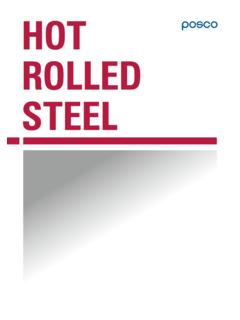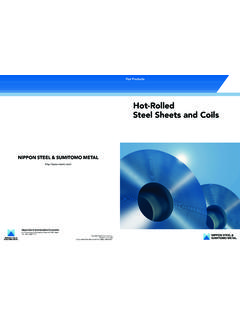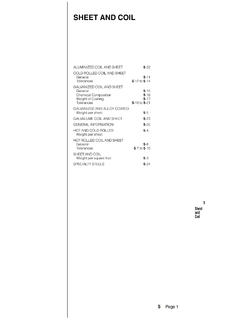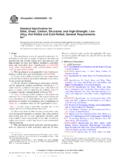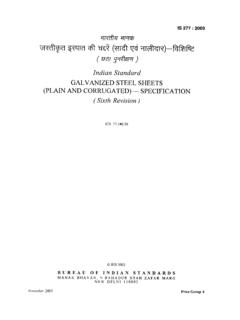Transcription of 'PSNBCJMJUZ …
1 Technology of Hot rolled Mild Steel Sheets & Steel Strips(Formability, Fatigue property and Spot weldability of SPHC Steel)Steel SheetsHot rolled Steel Manufacturing Co., rolled Mild Steel Sheets & Steel Introduction2. Characteristics of manufacturing process3. Data of quality Chemical composition and mechanical property Press formability (CCV, LHER, Erichsen, and LDR) Press formability ( FLD ) Fatigue property Spot weldability Range of suitable welding current Evaluation of joint strengthContents 3566711131414161 Amount of carbon dioxide emissions and amount of energy consumption under productionReferences:1) Makoto Nishino: Theoretical evaluation of CO2 emission by integrated steelmakers , Ferrum, , (1998), ) Environmental Affairs Group, the Japan Iron and Steel Federation.
2 Efforts against environmental problems in steel manufacture industry, Tekkokai (1992), ) Agency for Natural Resources and Energy, Ministry of Economy, Trade and Industry and the Japan Iron and Steel Federation: Energy evaluation study for use of steel products seen from LCA viewpointComparison of the amount of carbon dioxide emissionsComparison of energy consumptionElectric furnaceElectric furnaceBlast furnace 1 Blast furnace 2 Blast furnace 3 IntroductionThe Okayama Plant of Tokyo Steel started the production of hot- rolled mild steel strips from electric furnace steel by introducing the leading-edge DC electric furnace-hot strip mill in October 1991. We also introduced the continuous pickling line in 1995, cold rolling mill and surface treatment line in 1997 and leveller/shear line in 2004 to address the current manufacture of hot- rolled mild steel sheets and strips, pickled steel sheets and strips, hot-dip galvanized steel strips.
3 By studying and developing the technology to effectively utilize the tramp elements (traveling elements) such as Cu which increase in volume as the number of recycling count grows while utilizing the accumulated operation know-how, we provide high-quality and environmentally friendly electric furnace steel materials that suit the needs in a wide range of fields including industrial machines, home appliances and Steel s Views to Global WarmingSource: Home Page, Tokyo Steel Manufacturing Co., 1997, the Kyoto Protocol became the world s first international agreement on the issue, producing commitments by principally European countries and Japan to reduce their CO2 emissions in 2012 by about 5% compared with 1990.
4 Further discussions have been continued at the summits and international conferences, trying to determine additional and stricter targets, and to fashion a system in which all nations can action against global warming is the responsibility of current generations. We must act now to reduce CO2 emissions and develop the alternatives for fossil fuels to preserve the Earth's Japan, the CO2 emissions of the steel industry account for a little over 14% of the total (FY2008), the highest proportion among all the industries. Since steel is essential for the society to achieve industrial development, there is a clear need to find a way to reduce CO2 emissions in manufacturing is a big difference in CO2 volume between two methods being used to manufacture steel; making one ton of steel through a blast furnace method using iron ore and coal as its main feeds emits two tons of CO2 compared with less than tons by an electric furnace method which is making steel through recycling of steel scrap.
5 For manufacturing exactly the same type of steel, the CO2 emissions from an electric furnace mill are one fourth of those by a blast furnace 1995, we brought the Utsunomiya works on stream, establishing basically almost the same product lineup and capacity that Tokyo Steel has today. During the 15 years since FY1995, we have got about a 440-thousand-ton yearly average reduction in CO2 emissions over the 15 years through replacing a supply of steel products which had been produced by the blast furnace mills. Therefore, we consider that Tokyo Steel has actually achieved a reduction in CO2 emissions equivalent to 35% of its FY1990 CO2 emissions, which is evidently a huge reduction compared With the 5% target set for Japan as a whole under the Kyoto we consider a substantial reduction of CO2 emissions, recycling of steel scrap should be further promoted in Steel s Views to Global WarmingSource: Home Page, Tokyo Steel Manufacturing Co.
6 , 1997, the Kyoto Protocol became the world s first international agreement on the issue, producing commitments by principally European countries and Japan to reduce their CO2 emissions in 2012 by about 5% compared with 1990. Further discussions have been continued at the summits and international conferences, trying to determine additional and stricter targets, and to fashion a system in which all nations can action against global warming is the responsibility of current generations. We must act now to reduce CO2 emissions and develop the alternatives for fossil fuels to preserve the Earth's Japan, the CO2 emissions of the steel industry account for a little over 14% of the total (FY2008), the highest proportion among all the industries.
7 Since steel is essential for the society to achieve industrial development, there is a clear need to find a way to reduce CO2 emissions in manufacturing is a big difference in CO2 volume between two methods being used to manufacture steel; making one ton of steel through a blast furnace method using iron ore and coal as its main feeds emits two tons of CO2 compared with less than tons by an electric furnace method which is making steel through recycling of steel scrap. For manufacturing exactly the same type of steel, the CO2 emissions from an electric furnace mill are one fourth of those by a blast furnace 1995, we brought the Utsunomiya works on stream, establishing basically almost the same product lineup and capacity that Tokyo Steel has today.
8 During the 15 years since FY1995, we have got about a 440-thousand-ton yearly average reduction in CO2 emissions over the 15 years through replacing a supply of steel products which had been produced by the blast furnace mills. Therefore, we consider that Tokyo Steel has actually achieved a reduction in CO2 emissions equivalent to 35% of its FY1990 CO2 emissions, which is evidently a huge reduction compared With the 5% target set for Japan as a whole under the Kyoto we consider a substantial reduction of CO2 emissions, recycling of steel scrap should be further promoted in rolled Mild Steel Sheets & Steel IntroductionIntroductionelectric furnaceiron CO2 ton/steel ton CO2 ton/steel ton 1from Brazil CO2 ton/steel ton 3from Australia CO2 ton/steel ton CO2 ton/steel ton CO2 ton/steel ton 2in Japanoverseasblast Amount of CO2 emissions per one ton of steel (products)
9 Accompanying recycles of steelReferences: 1 Makoto Nishino: Theoretical evaluation of CO2 emission by integrated steelmakers , Ferrum, , (1998), 2 In case of 50km land transportation after Ministry of Economy, Trade and Industry and Ministry of Land, Infrastructure, Transport and Tourism: A guideline for a calculation method on CO2 emissions in transport sector ( )(2010), 3 Ship & Ocean Foundation: A report on research concerning the reduction of CO2 emission from vessels August 2000 (assuming that the iron content of iron ore is 60%, Japanese version ).Hot rolled Mild Steel Sheets & Steel Characteristics of manufacturing process5 PAGEPAGEC haracteristics of manufacturing processcontinuous casting machinedegasserladle furnaceelectric furnacerougher millSTFfinishing tandem millRapid cooling equipmentwinding deviceheating furnaceslabDC furnace steel making planthot coilshippingskin-passwelderacid bathpickling lineoiler(oiling)(welding)pickled coilcut sheetleveller shear linezinc-coated coilcold roll mill(reverse cold roll mill)surface treatment Process drawing ( Flowchart )
10 Skin-passtension levellerzinc pot welding welderannealing furnacealloying furnace anti-corrosive chromating coater Characteristics of manufacturing processHot rolled mild steel sheets and steel strips by Tokyo Steel are produced by using:1) A large direct current electric furnace with eccentric bottom tapping (EBT) Steel scrap is melted homogenously and efficiently by optimized arrangement of electrodes. Low inclusion and low nitrogen content of steel are obtained by EBTW hile minimizing the mixture of impurities such as inclusion by EBT, we reduce the mixture of nitrogen to manufacture clean liquid ) Steel refining at ladle furnace Homogeneity of chemical compositions is obtained by stirring Ar-bubbling.










